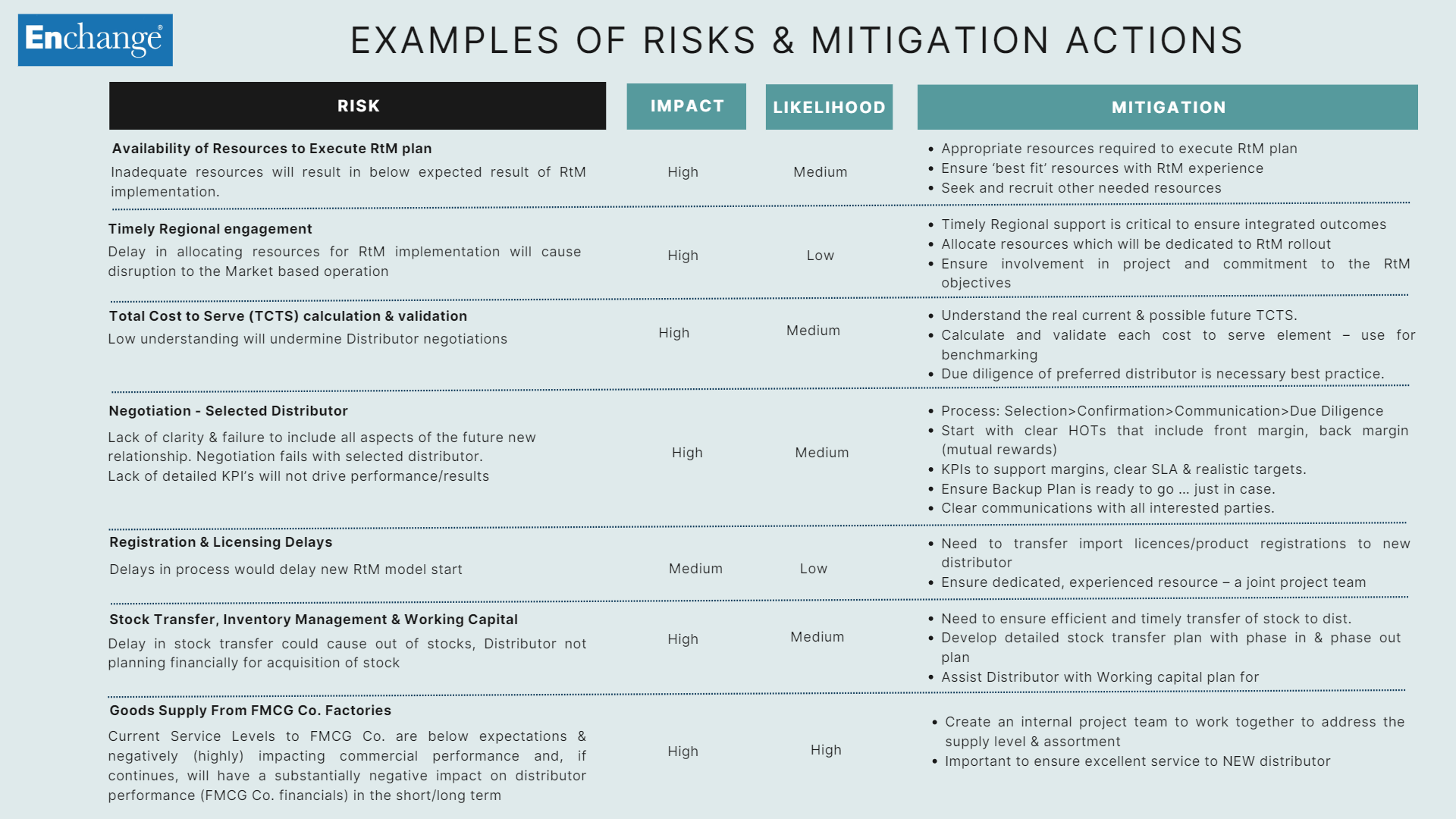Moving to a new Distribution Partner (DP) arrangement can be daunting, challenging, stressful, costly, rewarding, and ideally, successful. But no matter what the scenario, there are risks involved.
Producers who understand these risks and adapt their approach can significantly mitigate their potential effects.
Risk Management
Our approach to Risk Management has four pillars:
- Identification – map out likely risks considering RtM options, competitive position, county, etc.
- Impact – access the potential impact based on the specific situation in question.
- Likelihood – estimate how likely the risk is to manifest.
- Mitigation – what can be done to avoid, reduce, lessen, or weaken any risk.
Here is an example of a Risk & Mitigation Overview. Click here to see in larger resolution.

The key to Risk Management is Mitigation. This is the practice of developing plans and taking actions to reduce threats posed by each risk.
The focus is always on High Impact and High Likelihood areas.
But the first step is Risk Identification.
Risk Identification
The identification of risks is very dependent on the specific situation, the planned action or change, the country, a company’s current position, and most likely dozens of other factors. But to get things started, we have provided a list of 30 potential risks that may be involved when changing DP or moving to a new DP.
To help with the risk identification process, we split them into stages, in this case Preparation, Negotiation, RtM Execution, Marketing Execution and Partnership. This not only helps with clarifying the thought process, but it also allows us to interrogate our thought process by stage.
30 Potential Risks When Moving Distribution Partner?
Stage 1 - Preparation
1. Incomplete or poor due diligence2. Poor or badly thought-out transition plan
3. Lack of understanding or transparency around Total Cost to Serve
4. Misunderstanding or limited knowledge of local culture/environment/trading practices, etc.
5. Unclear or misunderstood Producer strategy
Stage 2 - Negotiation
6. Lack of clarity of HOT’s (Heads of Terms)
7. Unclear and/or inconsistent TT&Cs (Trading Terms & Conditions)
8. No agreed or understood KPIs (Key Performance Indicators)
9. Poorly defined SLA’s (Service Level Agreements)
10. Unrealistic targets set
11. Poor engagement with potential DP’s / existing customers
Stage 3 - RtM Execution
12. Loss of volume during RtM change
13. Lose and/or dissatisfy Current Customers (& Key Accounts)
14. Failure to deliver continuity of supply & service
14. Misdefined or understood territories (geographies, channels, and customers)
16. Bad credit risk management
17. Poor trade coverage and sales data feeds
18. Poor trade execution & retail activation
19. Lack of commitment or focus
20. Poor operations (supply chain, warehouse, S&OP, etc)
Stage 4 - Marketing Execution
21. Poor timing, detail, documentation and testing for product importation and registration22. Poor understanding and execution of portfolio strategy
23. Bad execution of agreed pricing strategy
24. Limited or bad overall Advertising & Promotion (A&P) support
Stage 5 - Partnership
25. Poor initial relationship management26. Lack of focus or dedicated resource by Producer or DP
27. Lack of commercial significance on either side (Producer is 5% of DP, or vice versa)
28. No Joint Planning or Investment
29. No commitment around joint reviews
30. Mistrust builds
Every situation is different, and this list is designed to get the thought process moving. Whatever the situation is, a very clear Risk Identification process needs to take place and then the focus will be on the High Impact and High Likelihood areas, and the Mitigation required.
What should you do now?
- Download our 8 Steps to Drive FMCG Distributor Excellence Implementation Guide which will give you the tools necessary to enter a market, to train RtM teams and to improve the performance of your FMCG Distributors.
Further help and resources
- If you need specific help on any RtM issue, please reach out to us.
- Use our 20 Steps to Route to Market Excellence modelto guide you on your RtM journey.
- Use the Enchange Supply Chain Houseto help with your Supply Chain Transformation.
- As we always say at Enchange, NOW is the time to be reviewing, building and/or transforming your RtM Strategy and Execution to reap the rewards. Do not wait. Feel free to use our 20 Steps to Route to Market Excellence Implementation Guideto help you.







